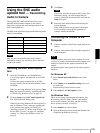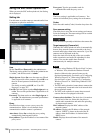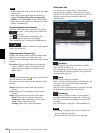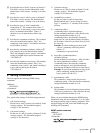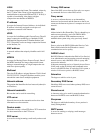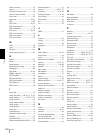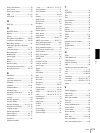
Others
Glossary
115
H.264
An image compression format. The standard written by
the JVT (Joint Video Team) a joint organization for
standardization (composed of ISO and ITU-T. H.264), is
capable of transmitting video data at a higher
compression rate than that of MPEG4.
IP address
Acronym for Internet Protocol Address. An individual
IP address is basically assigned to each piece of
equipment connected to the Internet.
JPEG
Acronym for Joint Photographic Expert Group. The still
image compression technology or standards of ISO
(International Organization for Standardization) and
ITU-T. Popularly used as an image compression format
on the Internet, etc.
MAC address
A network address that uniquely identifies each LAN
card.
MPEG4
Acronym for Moving Picture Experts Group4. One of
the MPEG standards for image compression format
aiming to transmit images at a high compression rate
with lower picture quality.
Multicast
The class D IP address assigned between 224.0.0.0 and
239.255.255.255. Using this IP address enables you to
transmit the same data to multiple equipment.
Network address
The portion that identifies the local network (subnet) in
an IP address.
Network bandwidth
Bit rate that can be used for networking.
NTP server
Network time server that transmits and receives time
information over the networks.
Passive mode
The mode whereby a client FTP allows TCP connection
for data transmission to the FTP server.
POP server
A server for storing incoming e-mail until you have read
it.
Primary DNS server
One of the DNS servers that can first reply to a request
by connected devices or other DNS servers.
Proxy server
A server or software that acts as an intermediary
between a local network and the Internet so that it can
connect to the Internet in place of a computer on a local
network.
PSK
Abbreviation for Pre-Shared Key. This is a shared key to
make an encryption key, used with TKIP in WPA
encryption standard. PSK sometimes means an
authentication system using a key previously shared.
QoS
Enter a value in the DSCP (Differential Service Code
Point) field included in the IP header to control
communication service quality.
RADIUS client
RADIUS (Remote Authentication Dial-in User Service)
is an authentication and accounting protocol managing
network access, and a RADIUS client is a party that
accesses the network.
In Internet connecting service, a Network Access Server
(NAS) such as that for dial-up and broadband access
server is a RADIUS client. In a wireless LAN system, a
wireless LAN access point is a RADIUS client.
Saturation
The degree to which a color is pure.
Secondary DNS Server
Subsidiary DNS server used when a primary DNS server
cannot be used.
Shared secret
A character string to be used for mutual authentication
between a RADIUS server and RADIUS client.
Sharpness
The degree to which the boundary of two portions is
clearly distinguished.
SMTP server
A server for sending or relaying e-mail messages
between servers.



